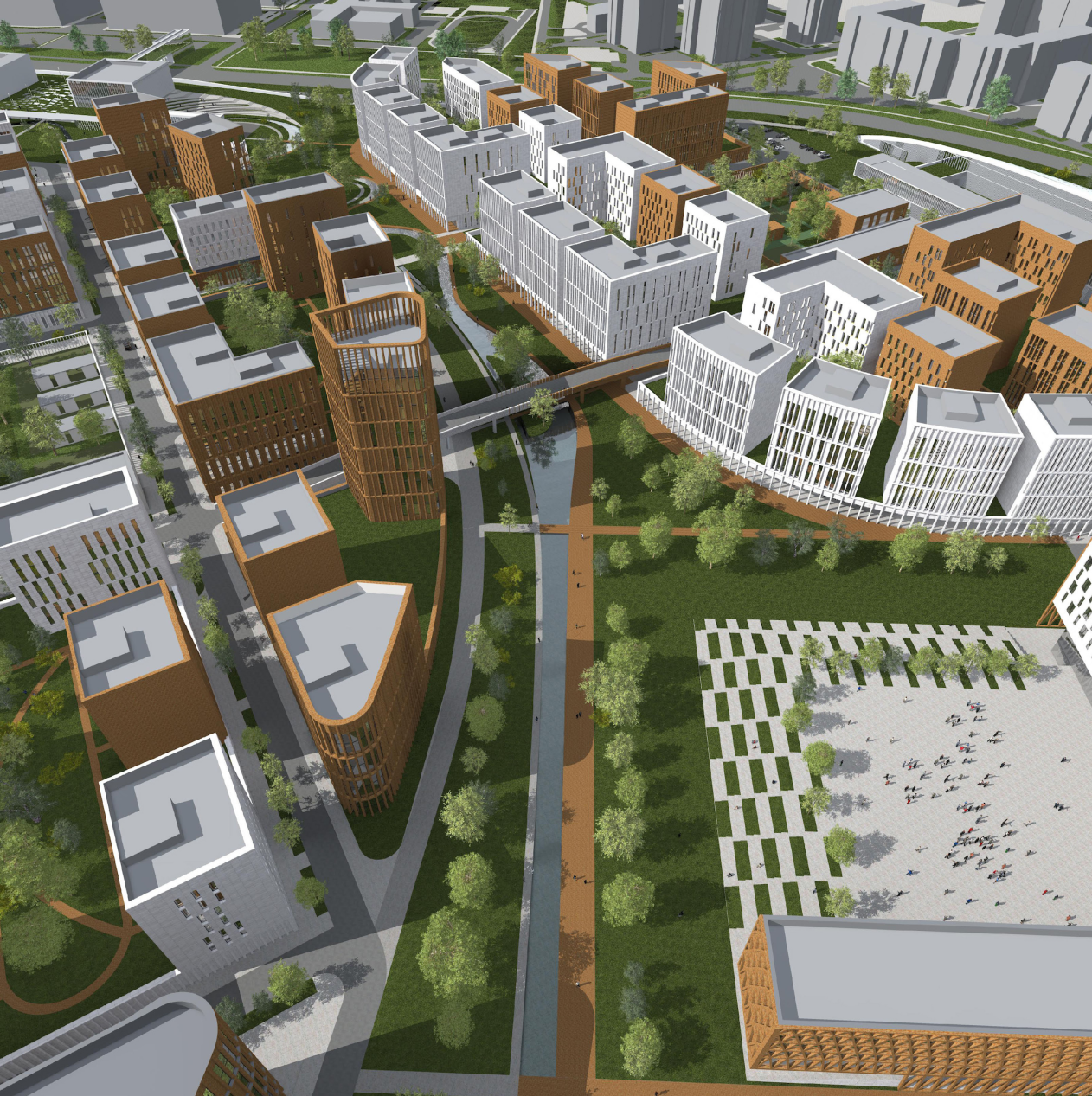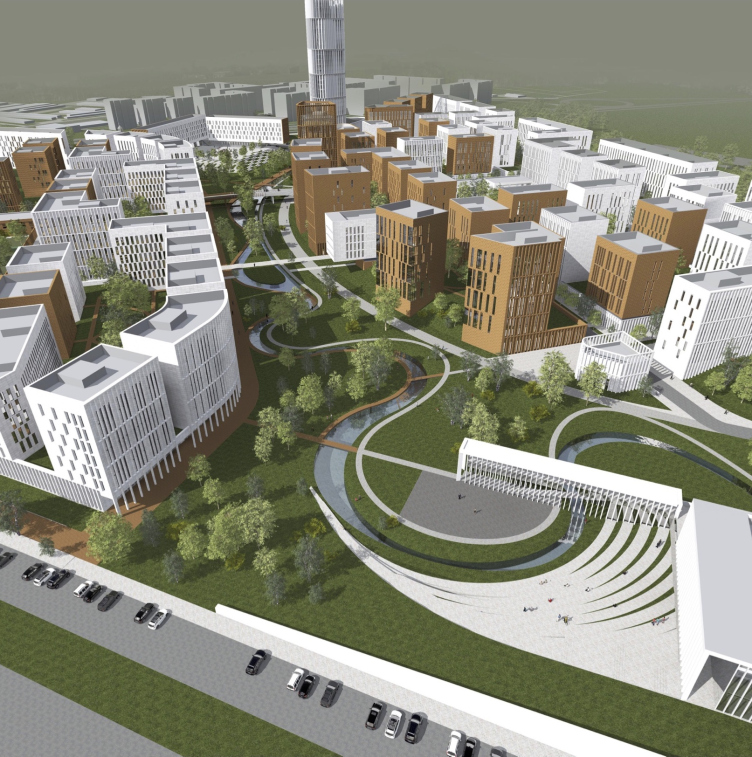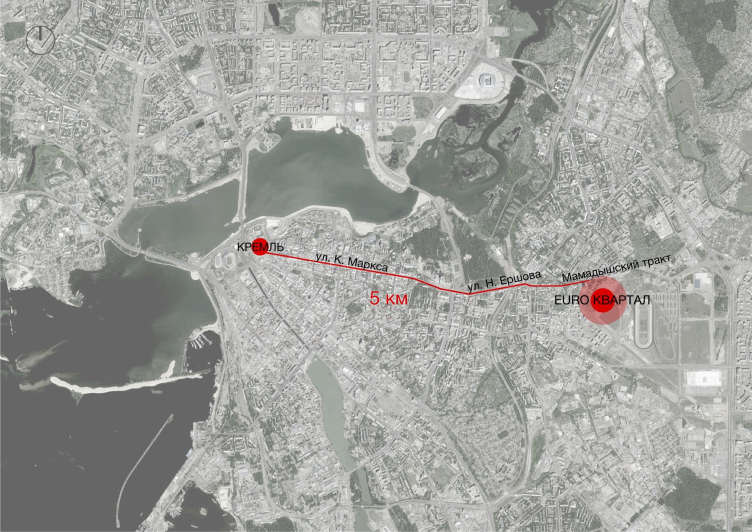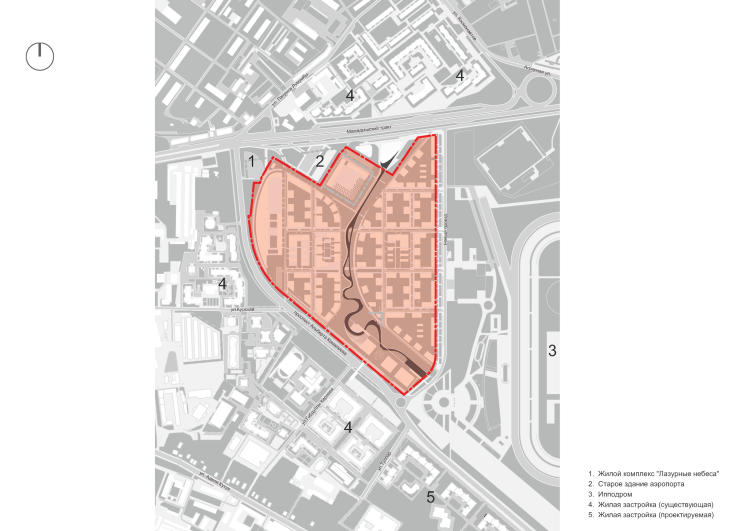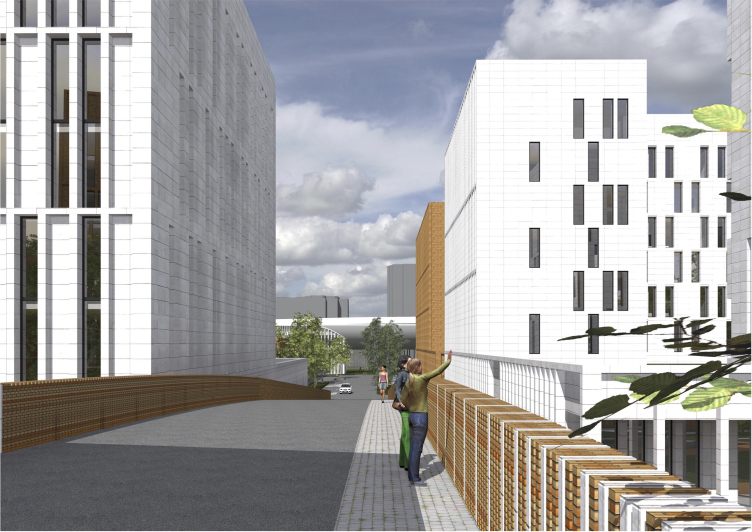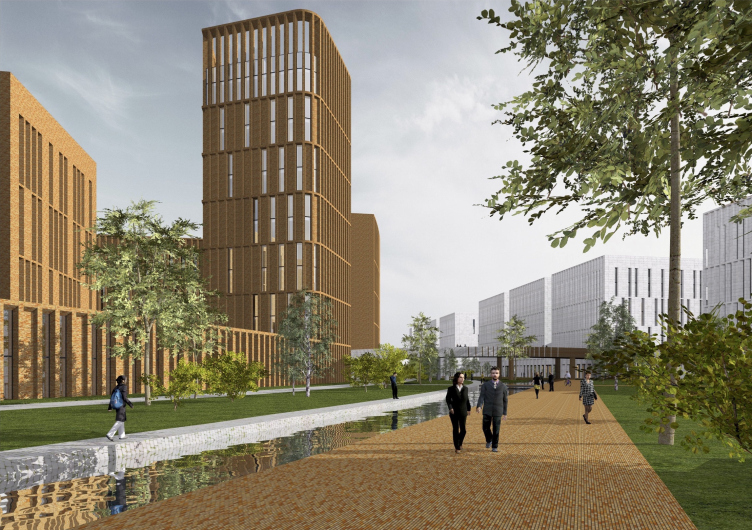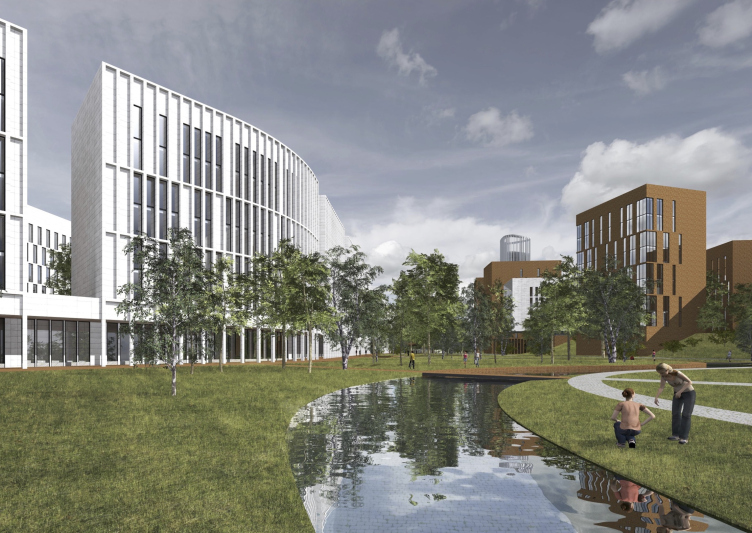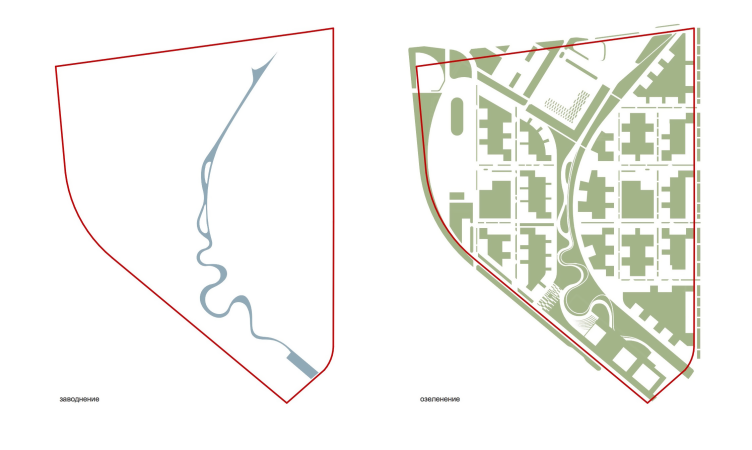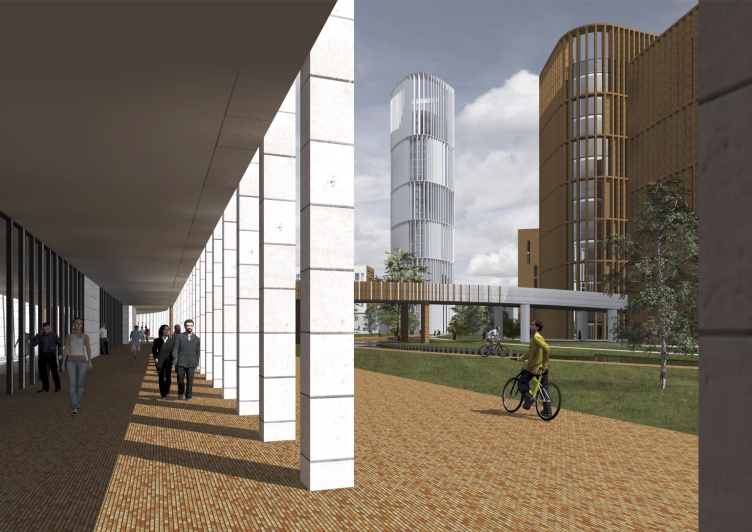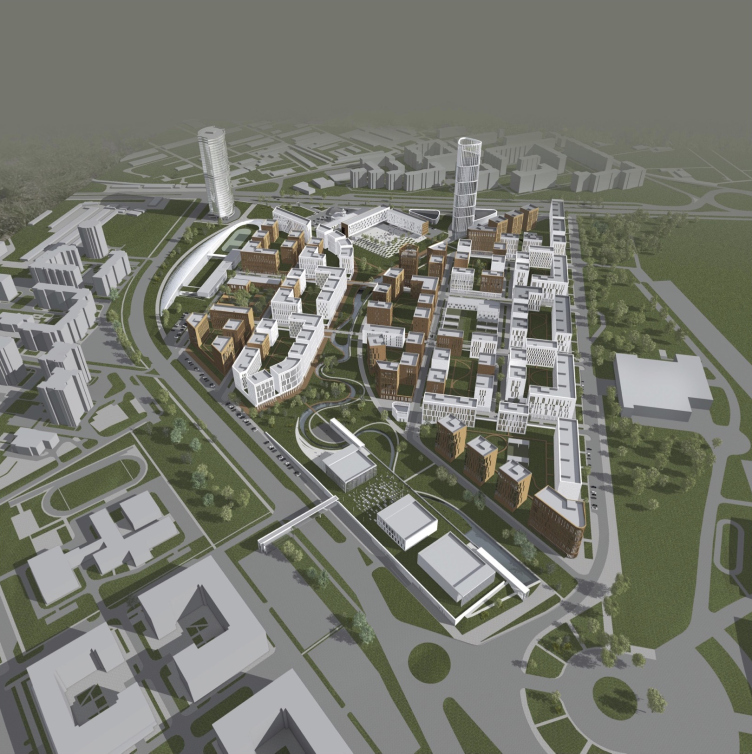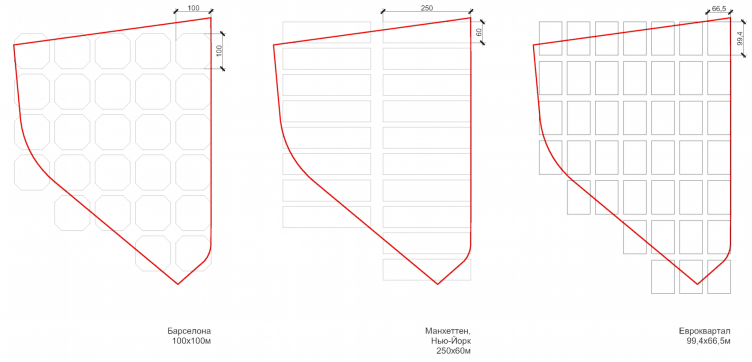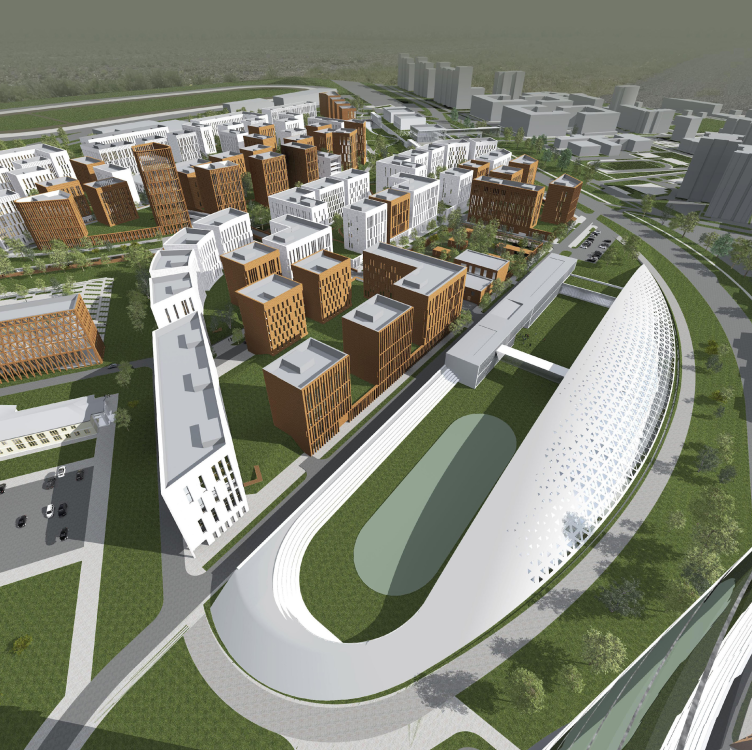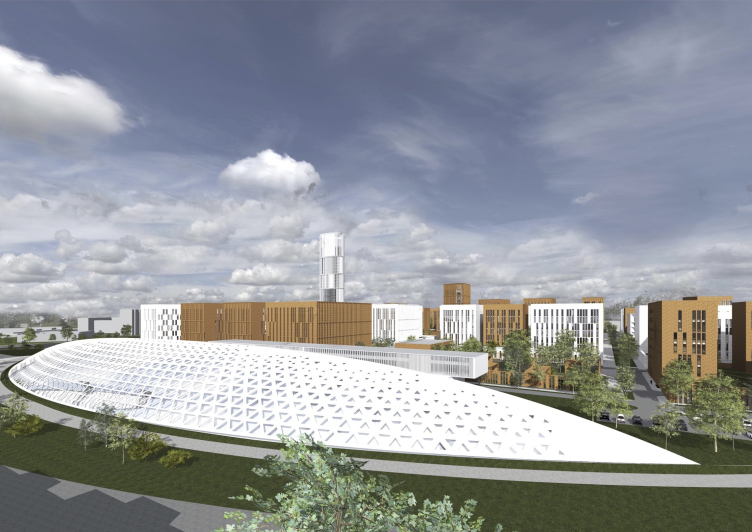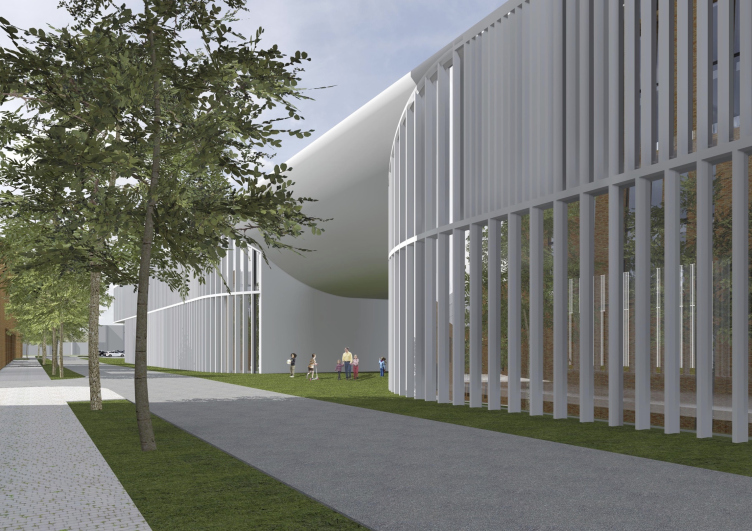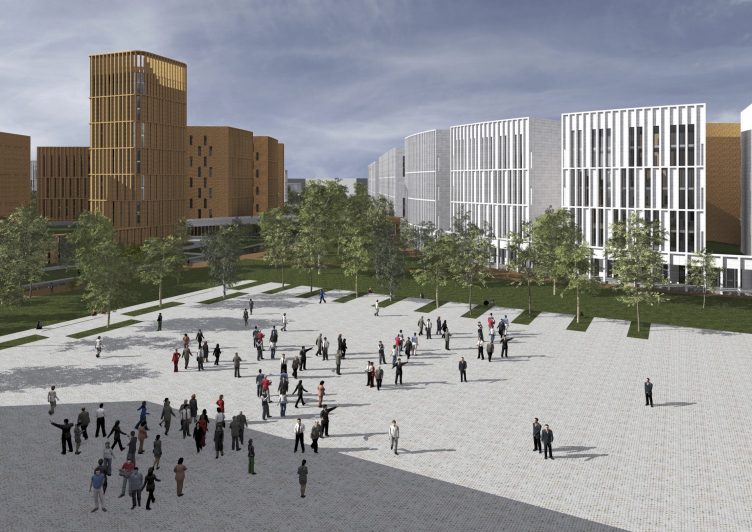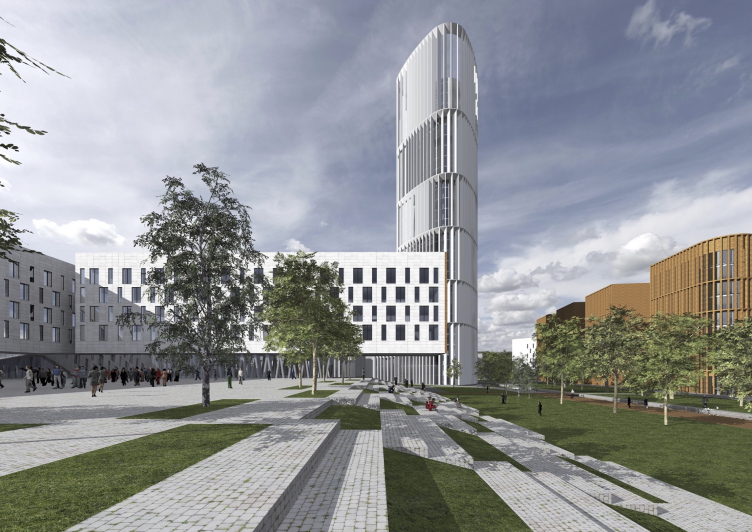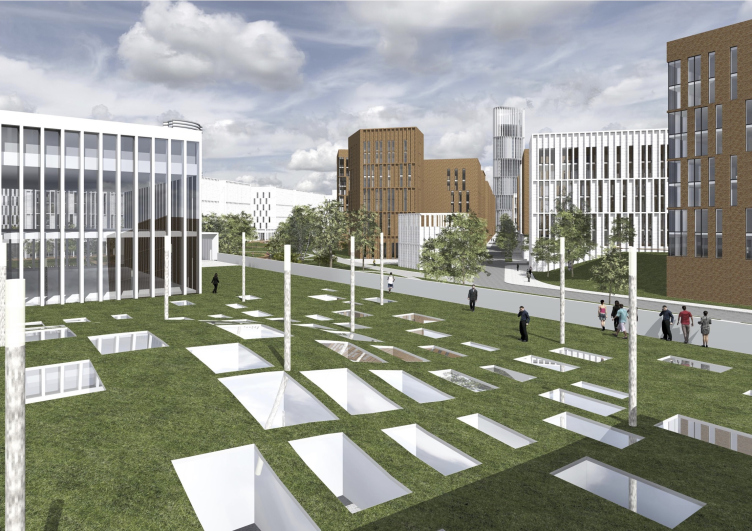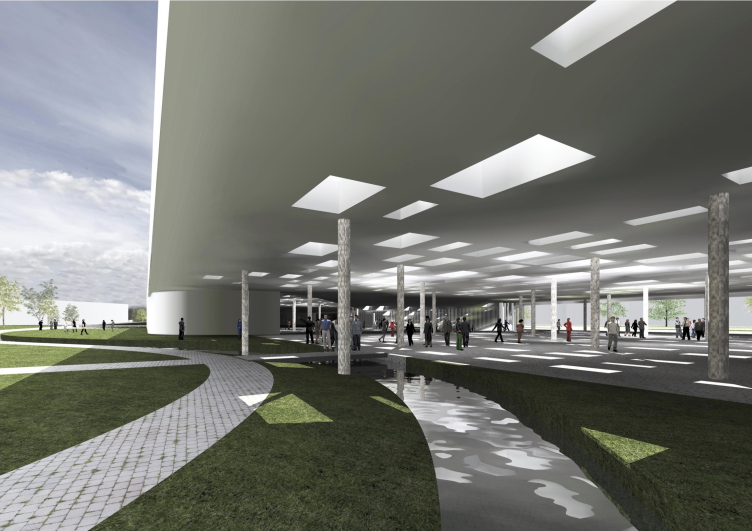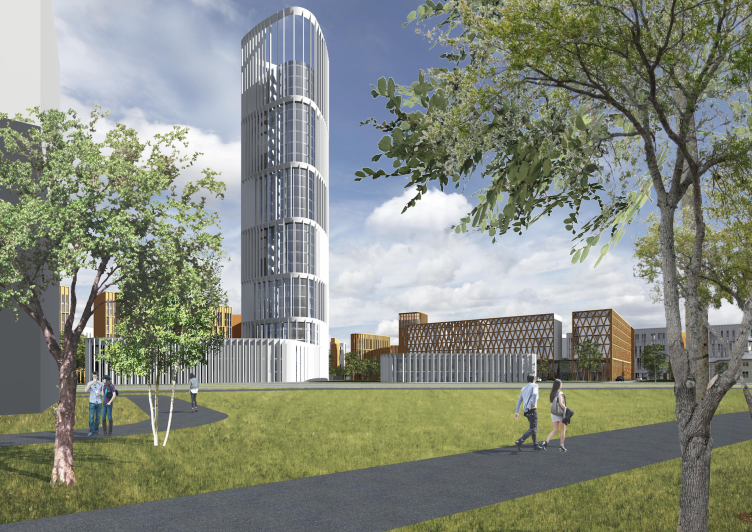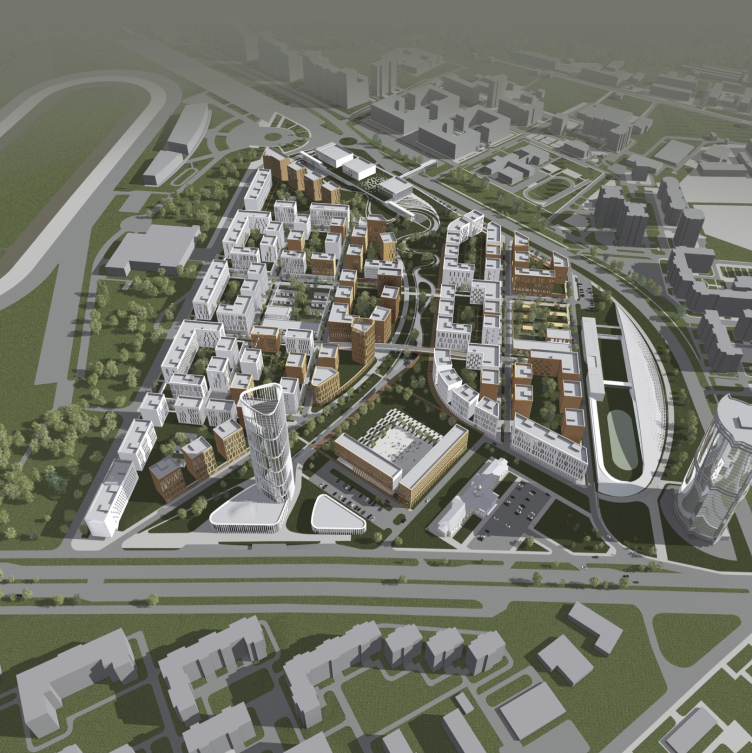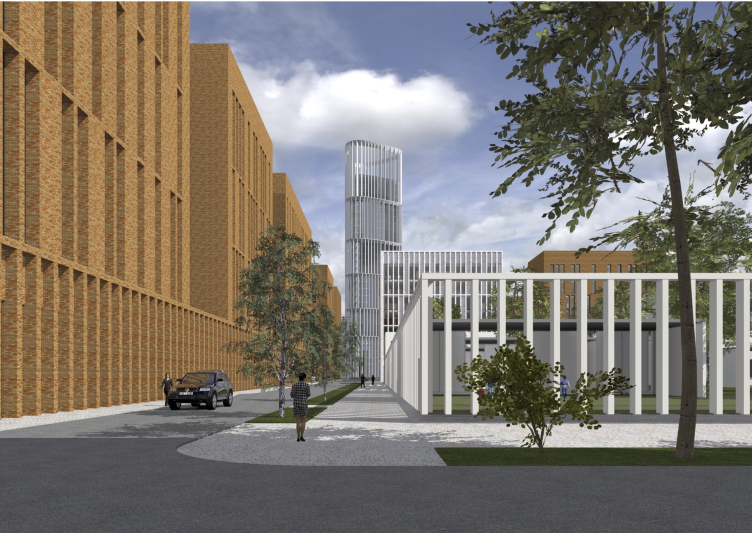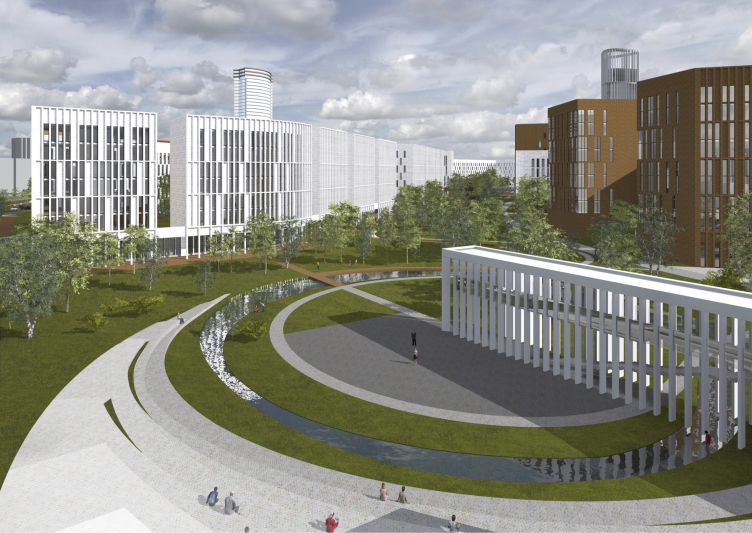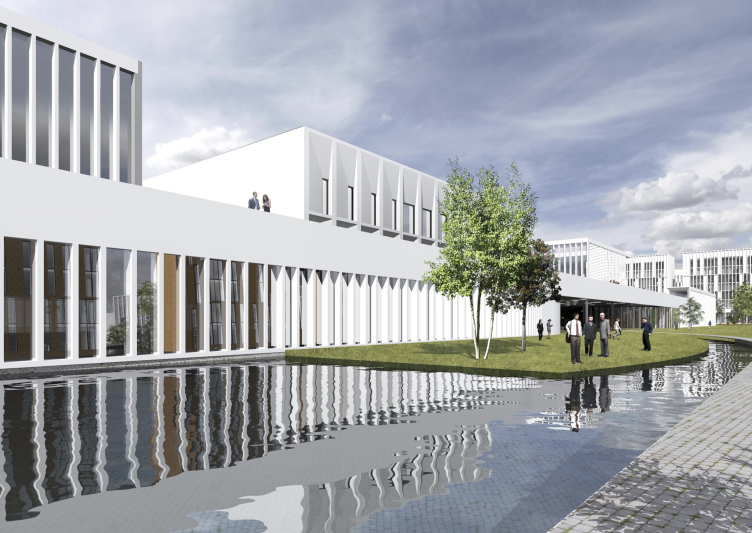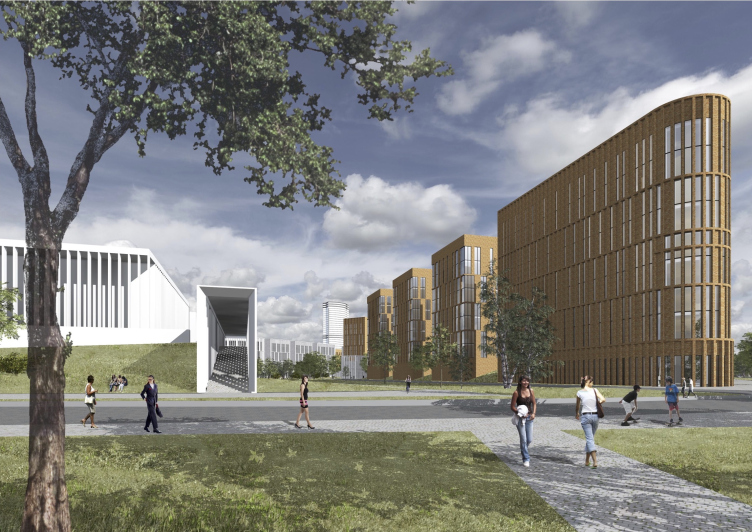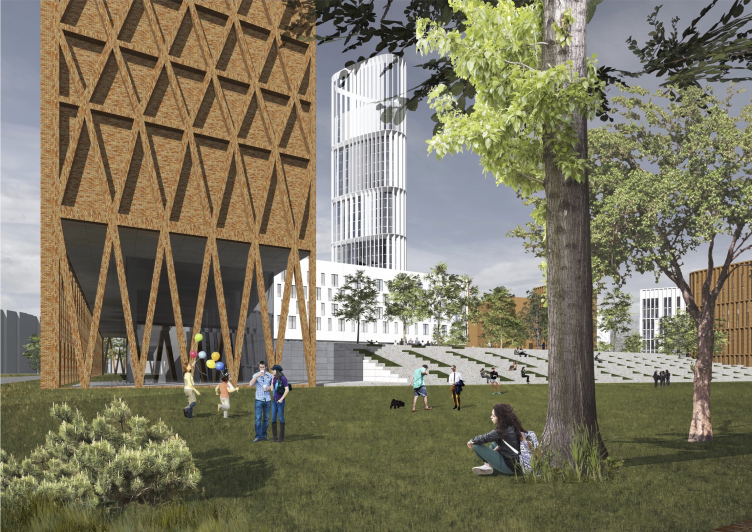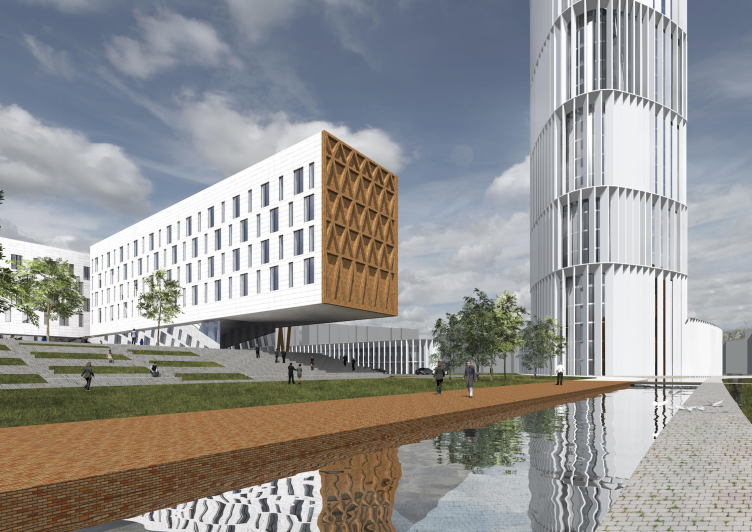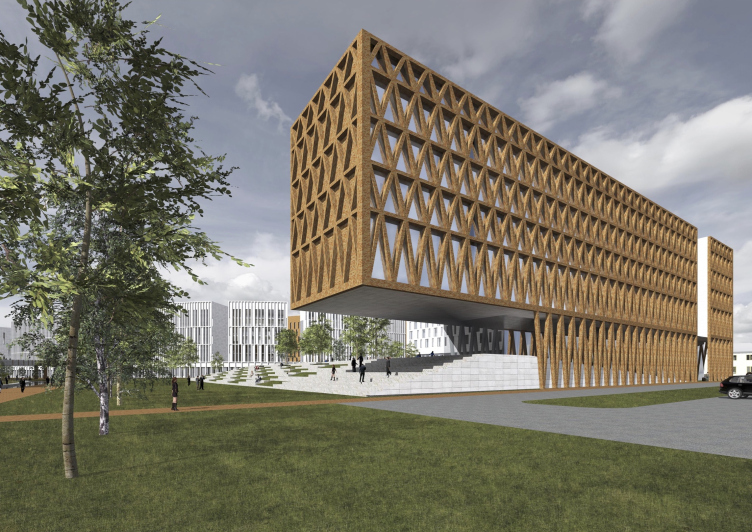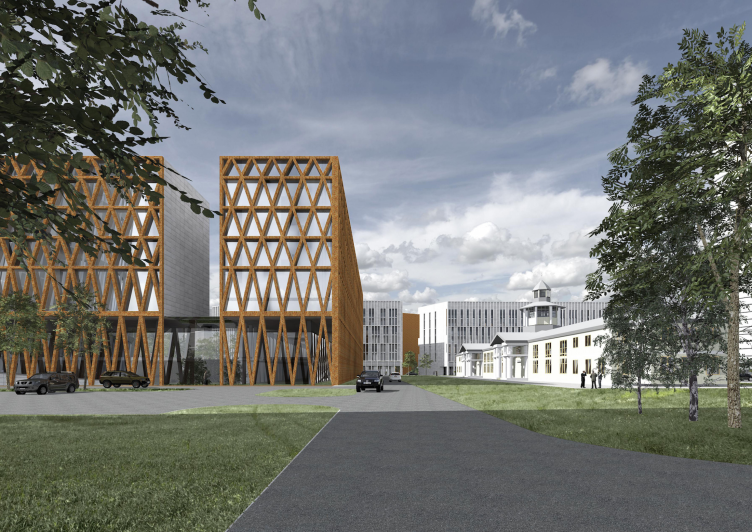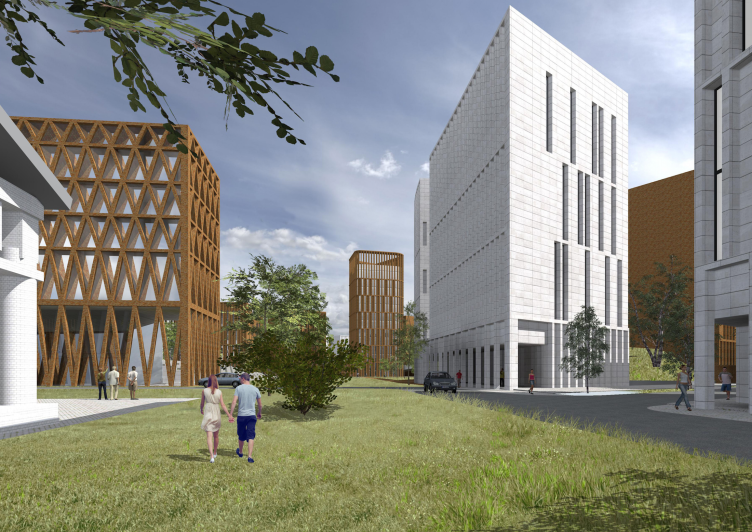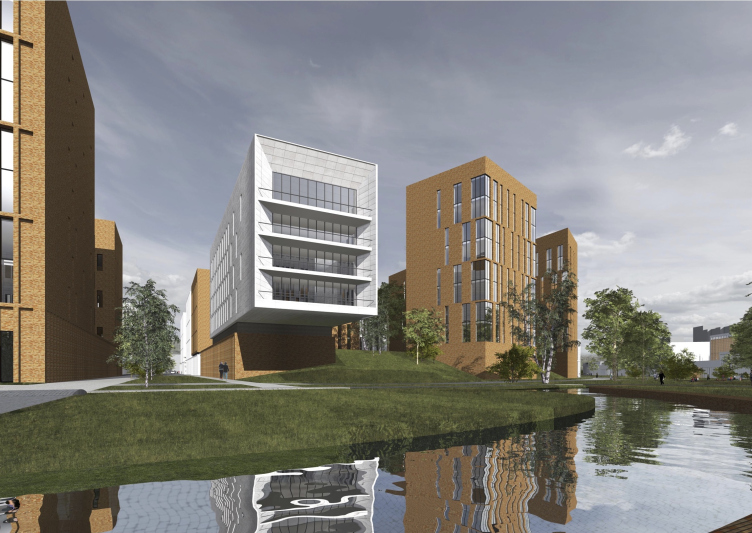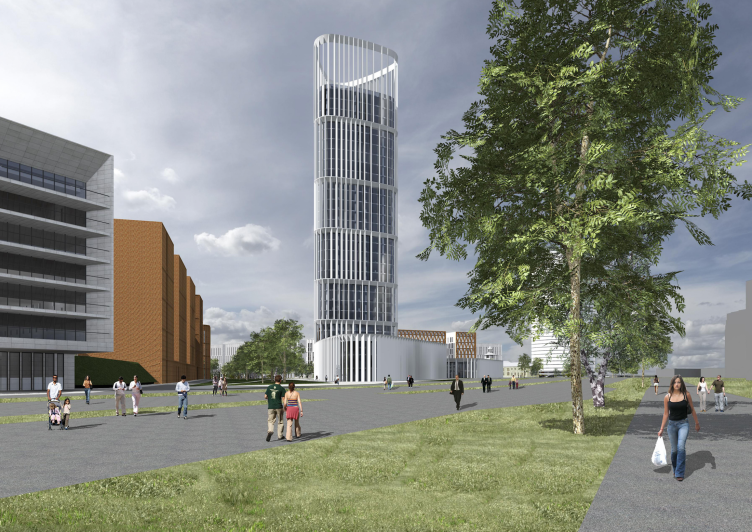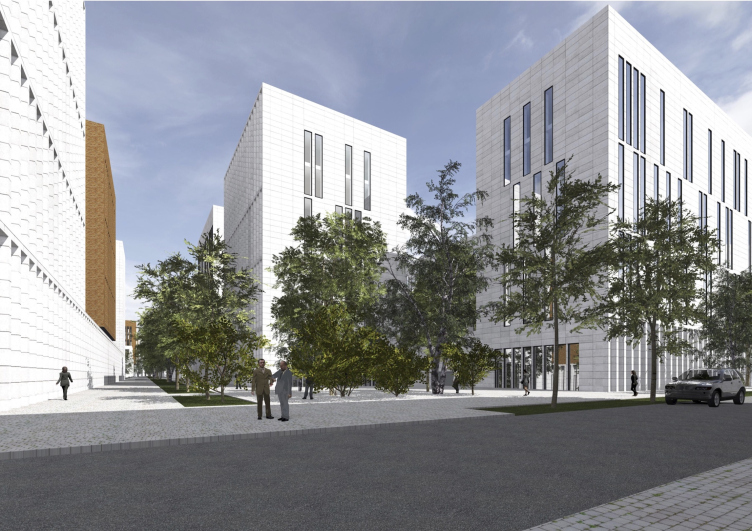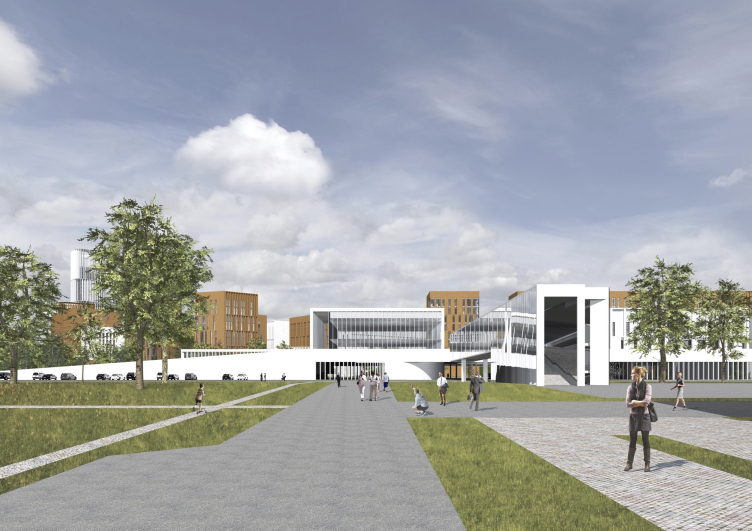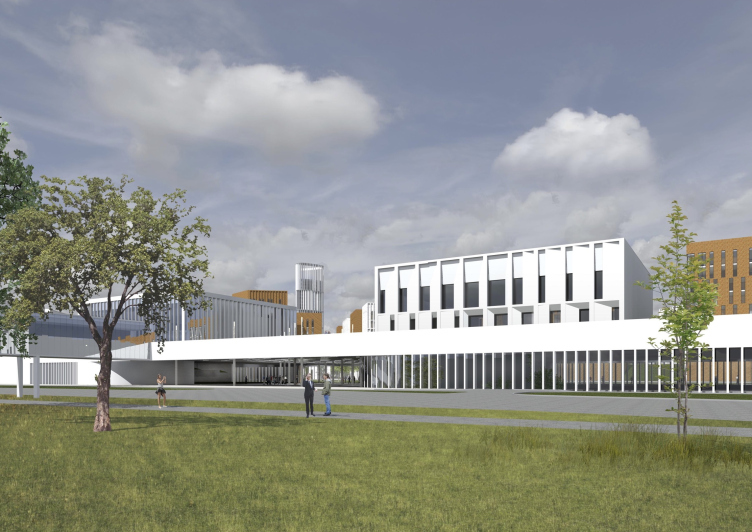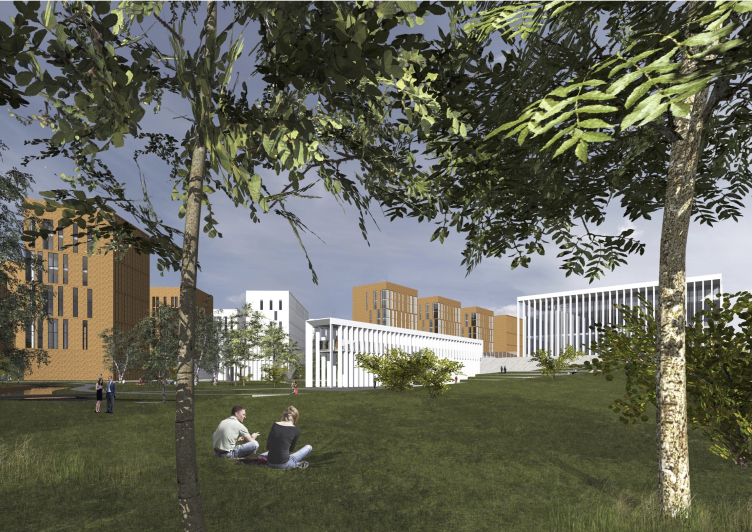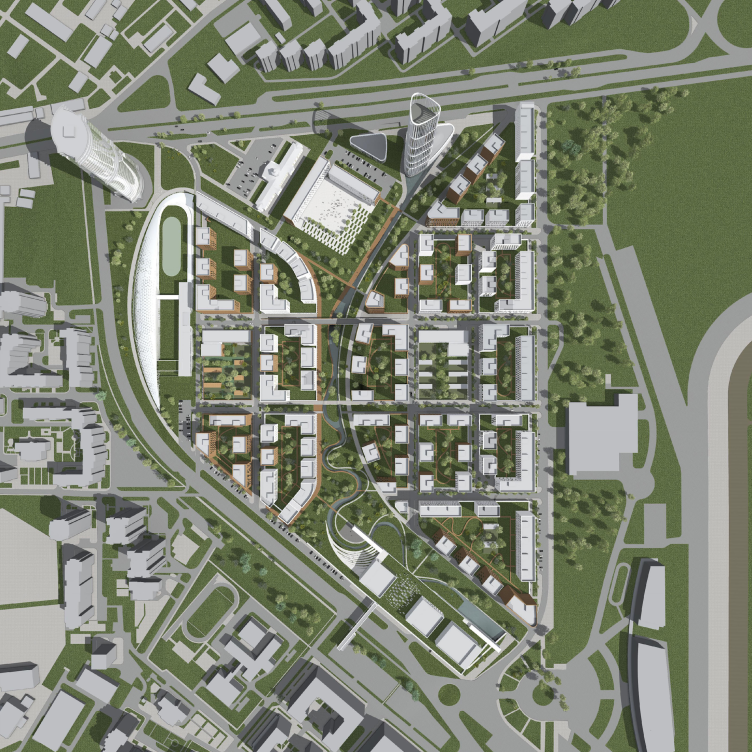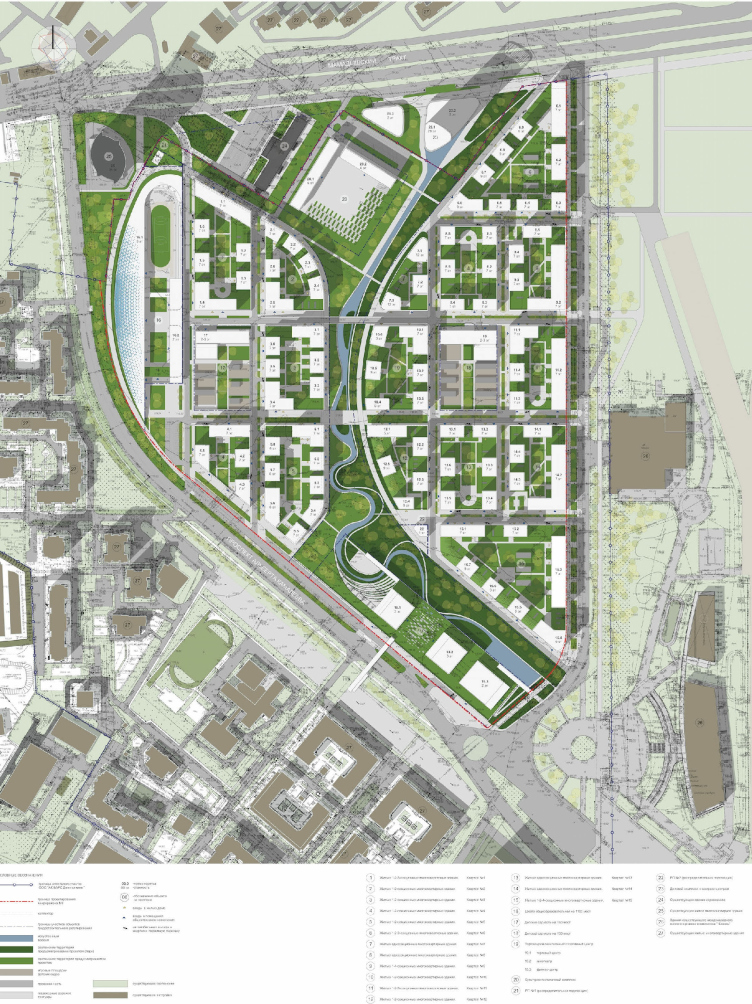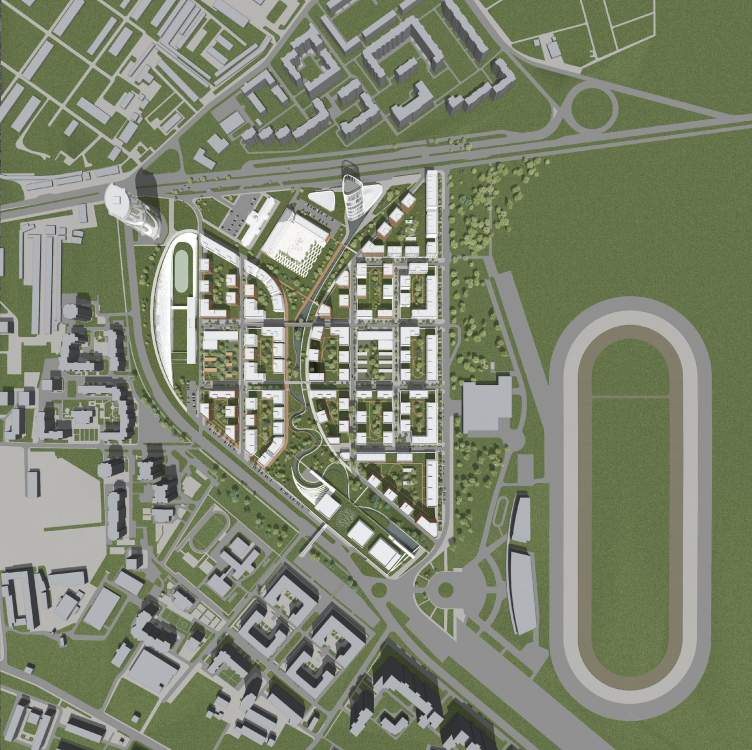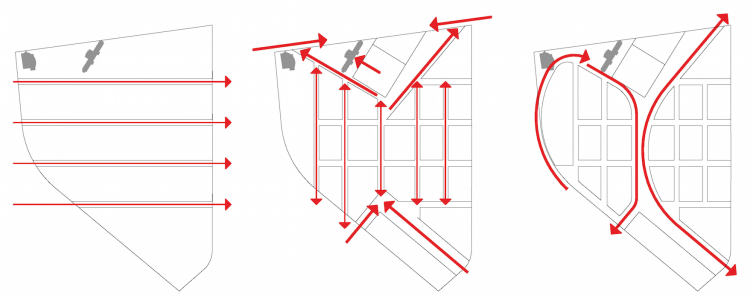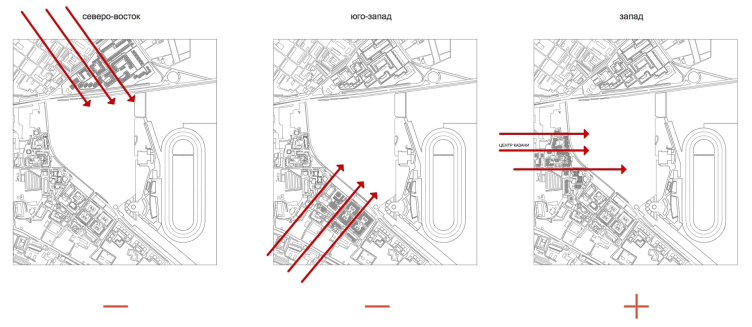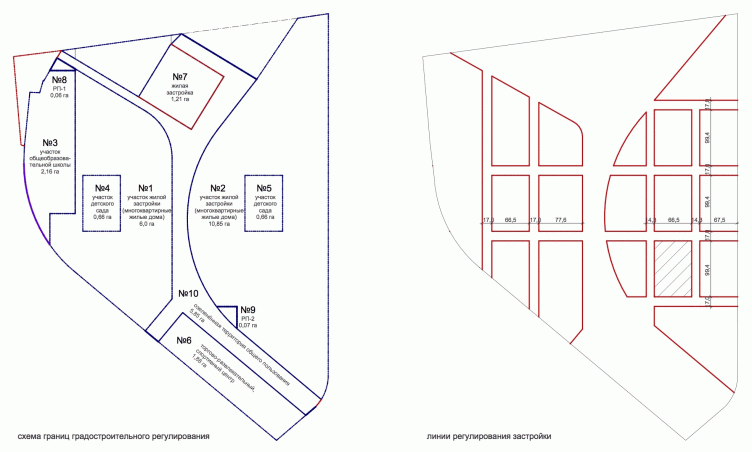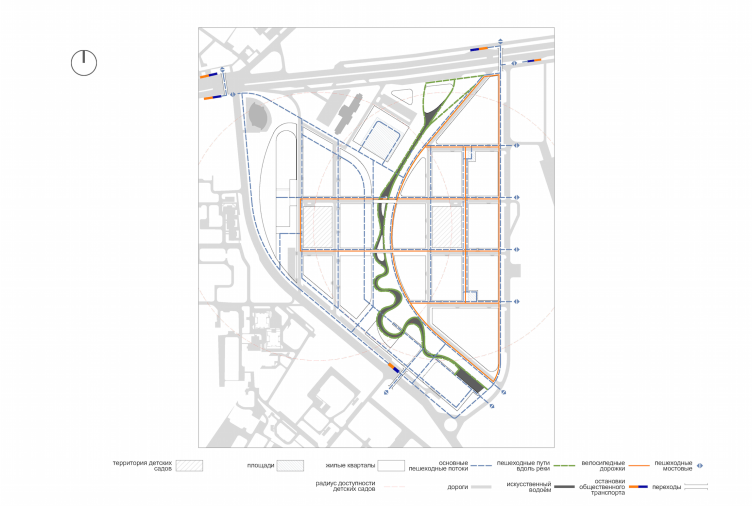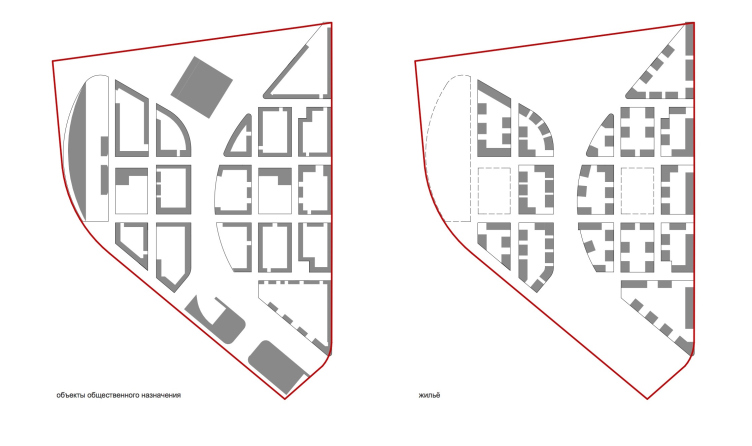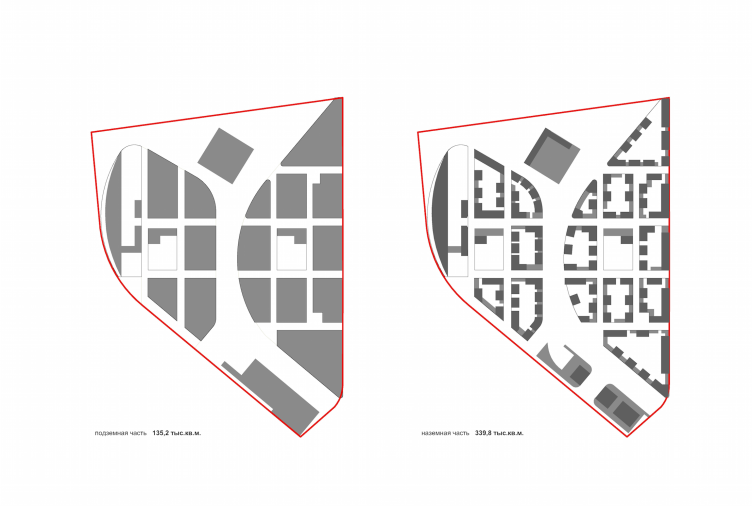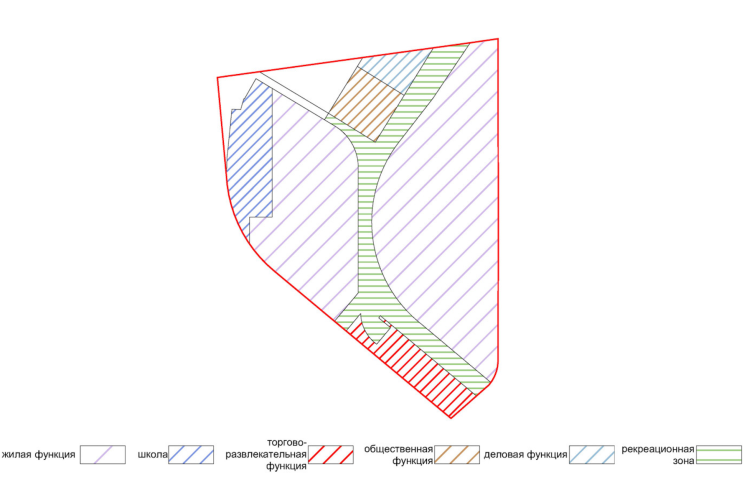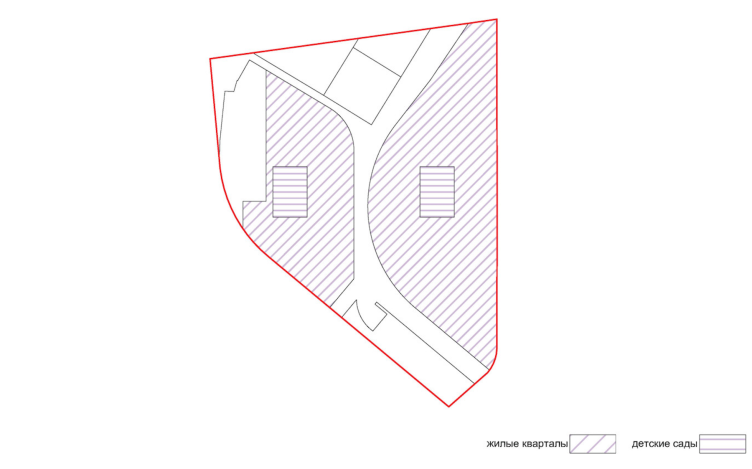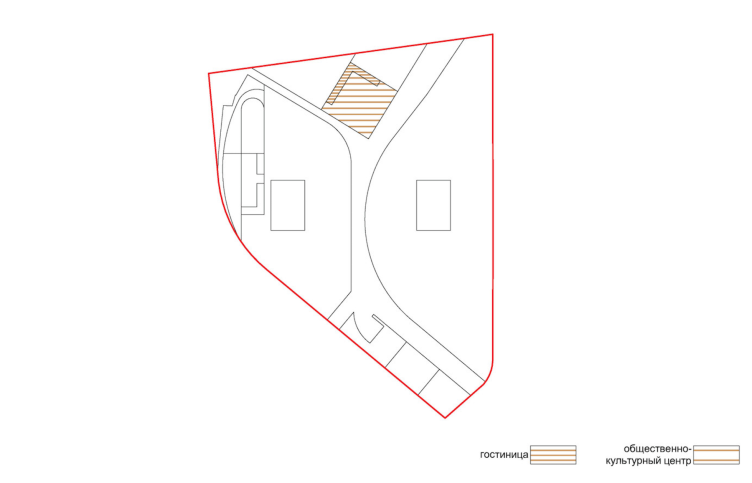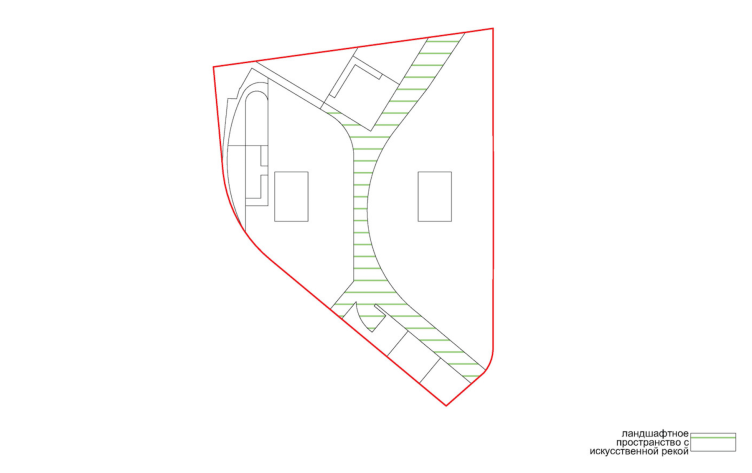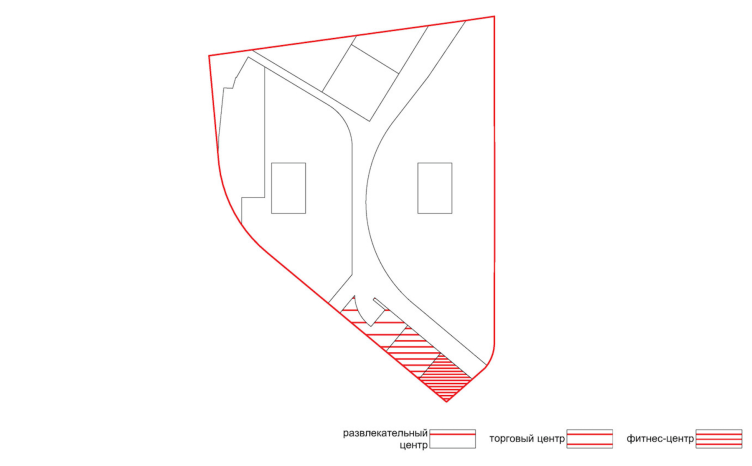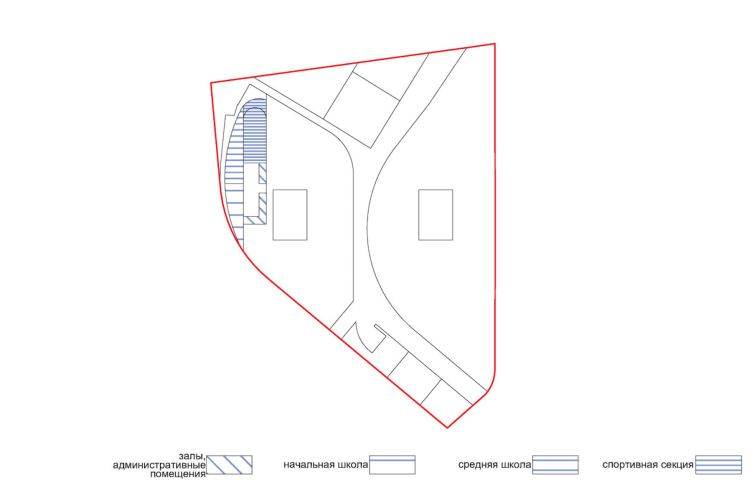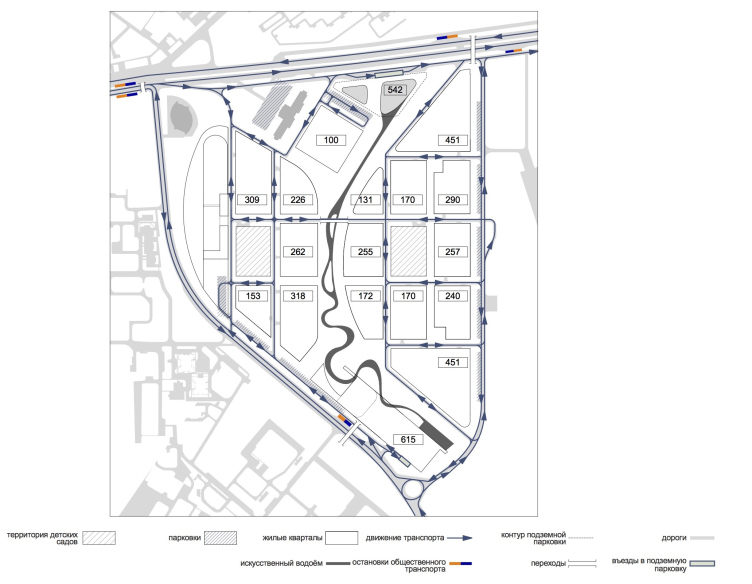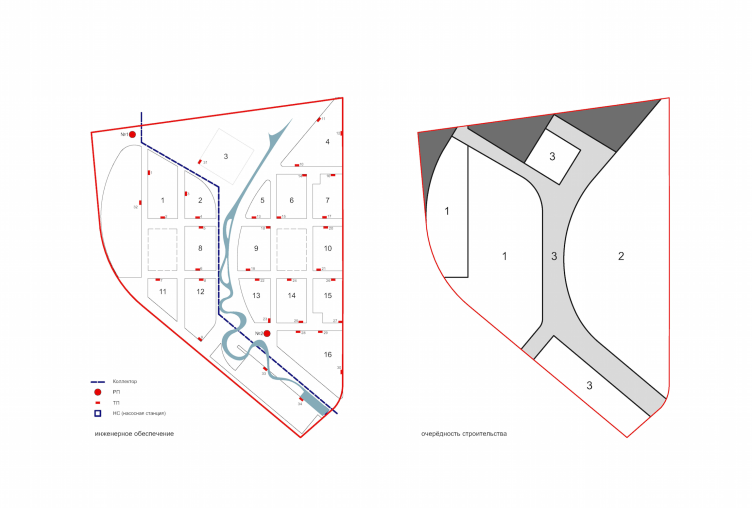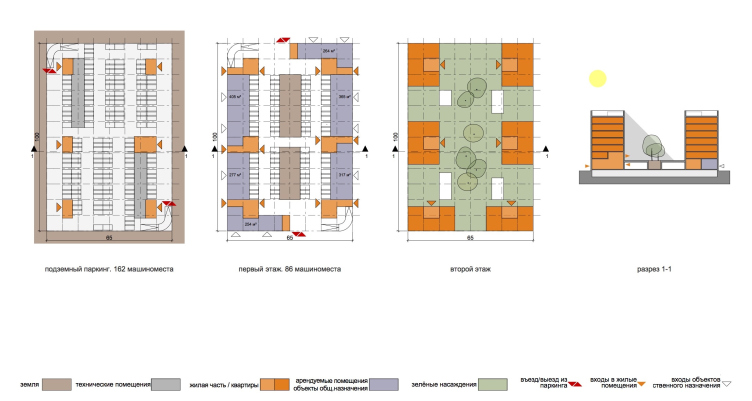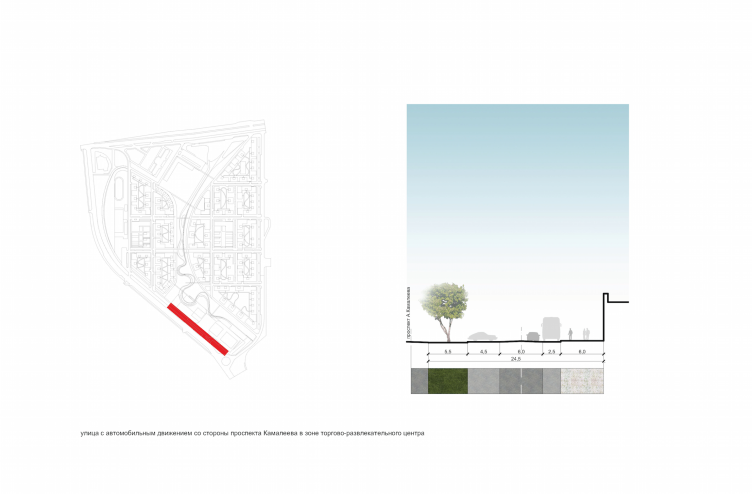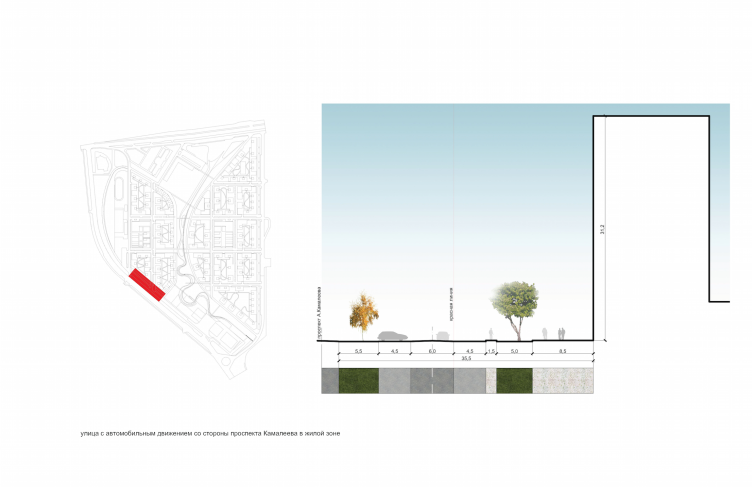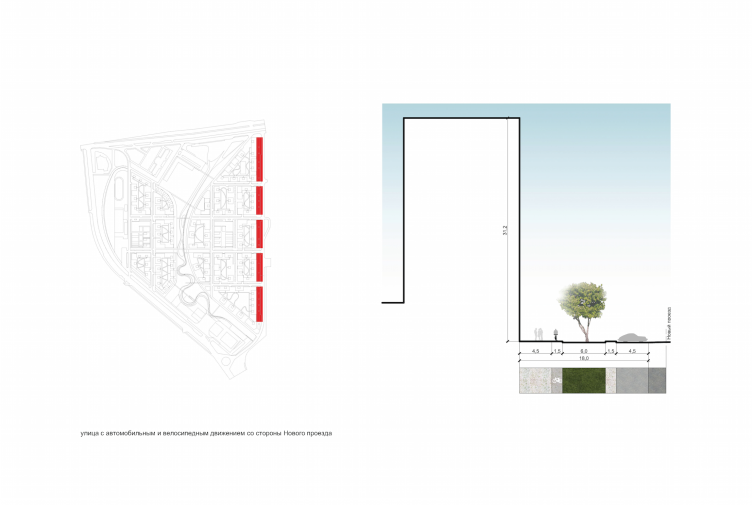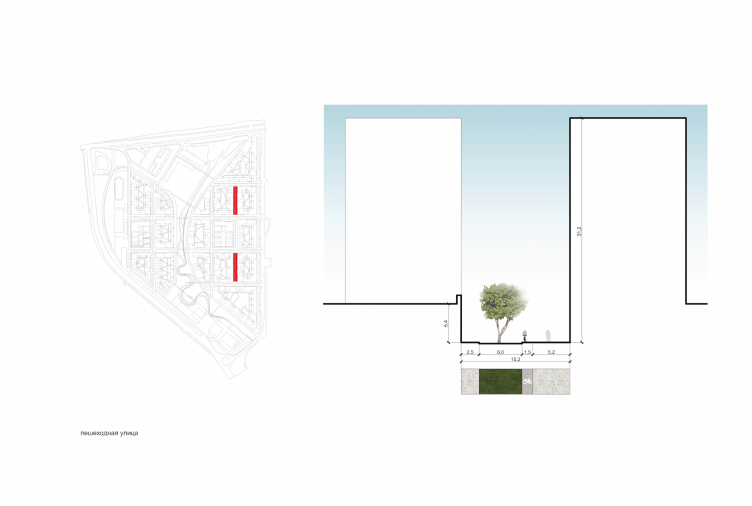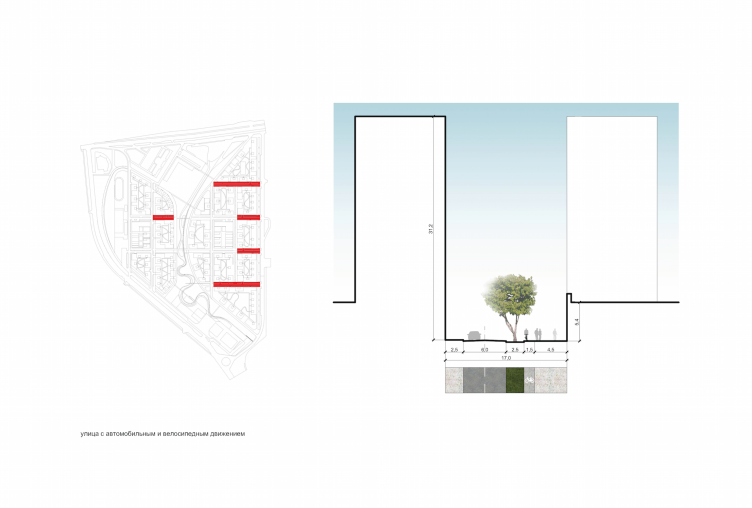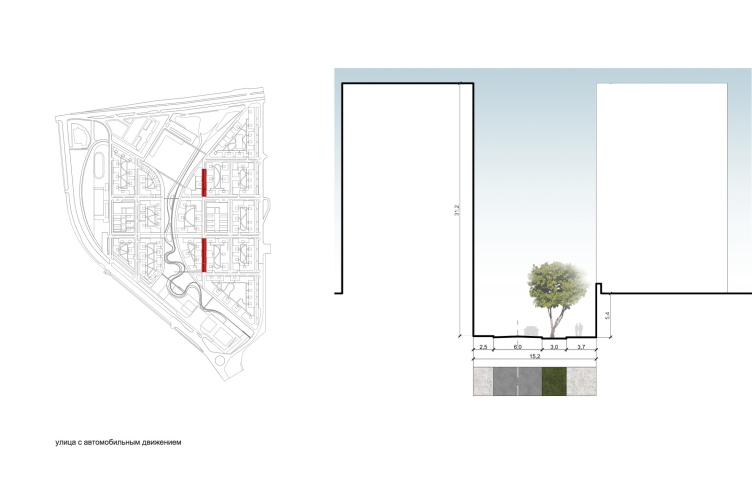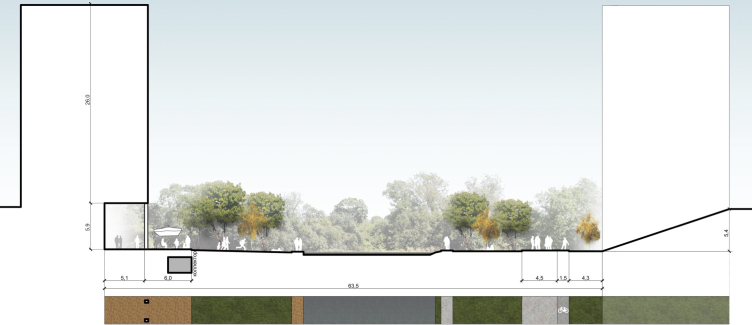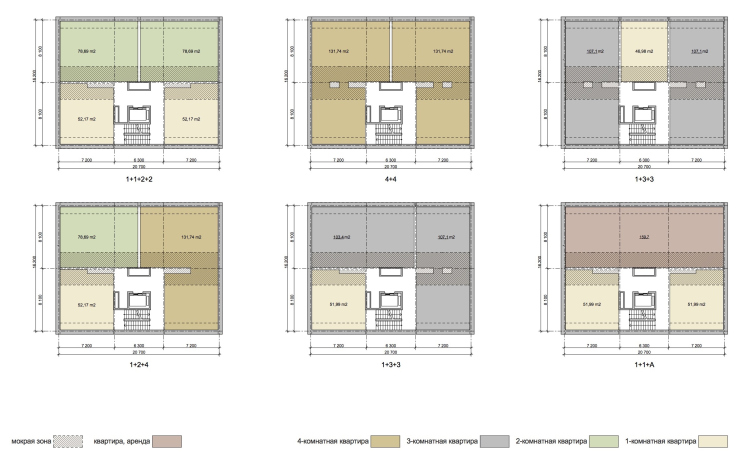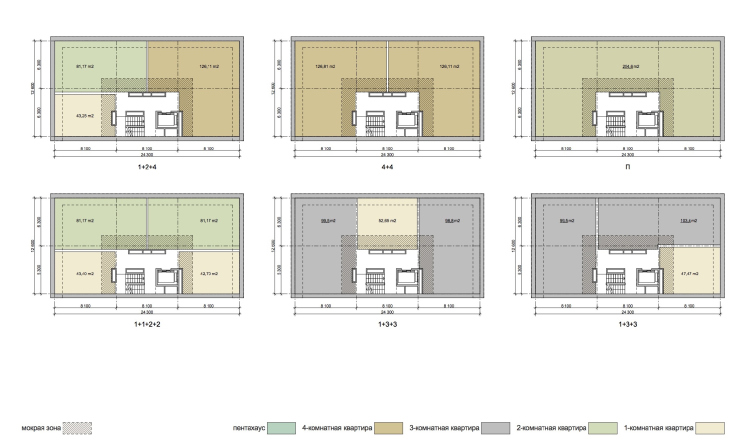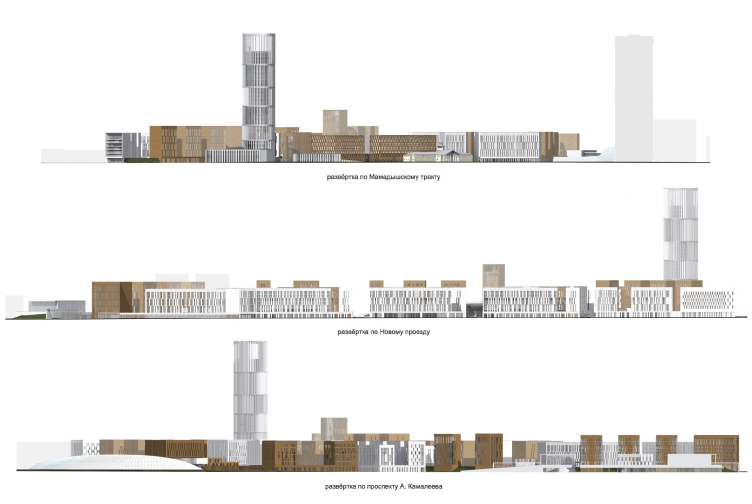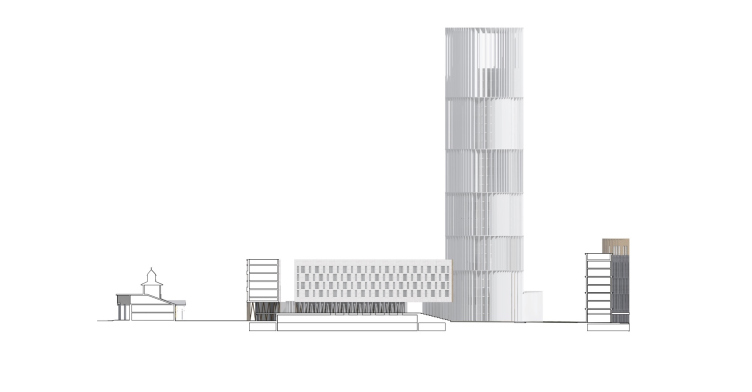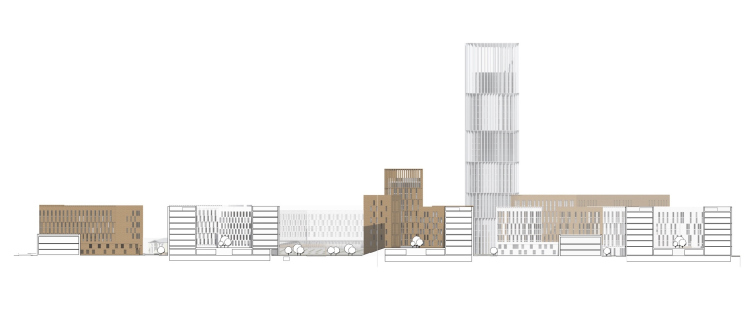“Euroquarter” or the M-8 micro district forms a part of a residential district “Sky Seven” – one of the ambitious projects of a large Tatarstan development company “Ak Bars Development”. For quite a long time now architects have been working on the design concepts for “Sky Seven”, whose territory surrounds the new hippodrome of Kazan on three sides; Asadov Architectural Bureau and a number of other workshops worked on the district in 2008; the before-crisis ideas were left on paper. Now “Ak Bars Development” is building a second stage of the micro district “Kazan XXI Vek” in the Eastern part of “Sky Seven”: twenty eight-storey buildings out of panels of the KDSK, former KPD-3 – the plant bought out and modernized by the developer was inaugurated in July.
The territory of “Euroquarter” is situated on the other, Western side of the hippodrome, in place of the old airport – whose building of the Stalin period is planned to be preserved, and near as of yet the only skyscraper in Kazan – the tower “Azure Skies” (460ft high). “Euroquarter” will also be built using the resources of KDSK but architecturally – let’s say – more personified. In 2014 “Ak Bars Develpment” considered holding an international tender, but having dropped this idea it decided in favour of Sergey Skuratov’s bureau upon the recommendation of the adviser of the company on architecture and urban planning – Dmitriy Puzyryov; and so the architects received an order for a design concept of the new district M-8. The work was done by the beginning of 2005. Now the concept has been seen and approved by the Chief Architect of Kazan – Tatyana Prokofyeva, the mayor and the interim president of Tatarstan; the project has also been shown to the Minister of Construction of the Russian Federation, Michael Men.
It is planned that during two years the architects will be thoroughly working with the project for launching several new production lines at the plant – so that when the construction begins it goes fast: as Head of “Ak Bars Development” says, this way the company wants to “reach the western practice”. At the moment the facades are not yet elaborated, but in the future Sergey Skuratov plans to expand the number of individual variants up to a hundred. “We are planning to offer a kind of LEGO, – says the architect. – A construction set that could develop afterwards”. The new production lines, more precisely – the new type of production and relationship between an architect and a house-building plant established by the project – could trigger a development of a completely different kind of panel construction in Kazan: flexibly variable and suited for multiple architectural choices. Since the project suggested by Sergey Skuratov is by no means a “typical” one in the traditional sense.
Project of building Kazan's "Sedmoye Nebo" ("Seventh Heaven") residential district. Bird' height view © Sergey Skuratov Architects
Project of building Kazan's "Sedmoye Nebo" ("Seventh Heaven") residential district. Location Plan © Sergey Skuratov Architects
Project of building Kazan's "Sedmoye Nebo" ("Seventh Heaven") residential district. Location Plan © Sergey Skuratov Architects
The main theme of “Euroquarter” is the image of the Volga and in general contemplation about the bordering location of Kazan between East and West. The lengthwise park located almost at the spot of the former takeoff strip, with a small man-made winding river has become the axis of the district. The water will be taken from an artesian well and “wound up” in a closed cycle: the river comes out under the office tower (somewhat taller than its former neighbor – 492ft), runs along the site following the variation of the relief (82ft), then goes under the ground where the pumps bring it back. The banks are cut in some places and low in the others, the river flows from North to South winding and forming a couple of small islands. In a word, this little “Volga” divides the assumed West and East that in the mind of Sergey Skuratov associate with two basic materials: brick and stone respectively. In the presentation sketch-book of the concept the figural poles are defined with two towers of Kazan Kremlin: the white Spasskaya Tower and Söyembikä Tower. The division is evident but conditional: the white-stone of the Spasskaya Tower actually refers only to its lower part, built under Ivan the Terrible (was he a man of the East or the West? He did not know it for sure himself. Probably, a man of West at the beginning of his reign, when he conquered Kazan). The same in the residential complex of Sergey Skuratov – the banks are not divided literally, white and brick facades are mixing, meeting and facing each other. Only the embankments are defined literally: the western is made of brick and the eastern is white-stone, and their “meeting” takes place on a footbridge in the form of a striped gradient with stone transiting into brick. In other words, the inexhaustible topic of East vs. West is shown but not imposed: one may contemplate it or not, being limited to observing the curious plastic effects of juxtaposing brick and stone. Apparently, the stone in the lower floors of the houses will be natural, and in the upper floors – concrete, man-made; the authors are considering adding oriental ornaments into the décor, that will emphasize the cultural difference between the houses and accent the intrigue of the project.
Project of building Kazan's "Sedmoye Nebo" ("Seventh Heaven") residential district. Pedestrian bridge © Sergey Skuratov Architects
Project of building Kazan's "Sedmoye Nebo" ("Seventh Heaven") residential district. Park, brick and whitestone embankments on the different banks of the river © Sergey Skuratov Architects
Project of building Kazan's "Sedmoye Nebo" ("Seventh Heaven") residential district. Park © Sergey Skuratov Architects
Project of building Kazan's "Sedmoye Nebo" ("Seventh Heaven") residential district. Bird's height view © Sergey Skuratov Architects
Project of building Kazan's "Sedmoye Nebo" ("Seventh Heaven") residential district. Landscaping © Sergey Skuratov Architects
And in truth, it is not so much about the Volga and the formal division of Europe and Asia. The whole Russia is made up of the transfusion of East and West, the idea that has been frequently put in words but never actually found its bottom line. This transfusion becomes noticeable suddenly, sometimes as something beautiful, inexplicable. Such is the “national” Russian architecture of the 17th century, as defined by the late romanticists, and it includes the Söyembikä Tower, the belltower of the Spasskaya – its stem is western and it looks curious, oriental, but the mixture of red and white is attractive. This is the way Sergey Skuratov mixes white and red houses: both for the sake of the idea and beauty. On the other hand, in our time Kazan managed to implement the western idea of an innovation centre earlier than Moscow, and so a European residential district with all the features of modern planning can appear in the near future.
However, the game of cultural East-West contraposition was basically invented by the European culture. In this project Sergey Skuratov stays more than a European – rational, subtle and aware of the latest trends. The network of the quarters is an orthogonal gridiron plan, strictly oriented to cardinal points. The authors suggest their own module for the quarter – twice as shorter than in Manhattan, but not as squared as in Barcelona, to be exact – 3261x2181 feet. Skuratov explains that this size is a result of calculations and is accounted for by a number of causes. The houses are not too high: the average number of floors is 8 or 9 – something in between the houses of Stalin’s time and commercial apartment buildings of the 19th century; closer to the 490 feet high office tower the height of buildings increases up to 12 floors. The yards are shut off from cars (gathered in the underground parking lot), lifted above the pavement, quiet and green. The ground floors are allocated for cafes and shops – coming out by the river they turn into galleries similar to Rue de Rivoli.
Project of building Kazan's "Sedmoye Nebo" ("Seventh Heaven") residential district. Gallery © Sergey Skuratov Architects
Project of building Kazan's "Sedmoye Nebo" ("Seventh Heaven") residential district. Bird's height view © Sergey Skuratov Architects
Project of building Kazan's "Sedmoye Nebo" ("Seventh Heaven") residential district. Bird's height view © Sergey Skuratov Architects
One of the characteristic features of the “Euroquarter” is the large area allocated for various, including public, infrastructure. It is a complete little town, much like an ancient middle-sized polis – it is to be populated by about five thousand people. No wonder that the authors intend to make a theatre with an attached outdoor performance stage here, as well as an amphitheater in the river bend, a small museum and a shopping and sporting centre with a square – “agora” in front of them. Two rectangles of the quarter amid the residential development are allocated for kindergartens, and two more kindergartens are built into residential houses.
But the most impressive thing is the school: its gigantic volume spread along the ground – bionic and calligraphic at the same time – reminds the twirls of the Arabic script. Covered with an ornament of triangular street lamps and flexible, it develops the “oriental theme” (the school is white), and begins a new line of thoughts – about the incursion of modern architecture into the relatively conservative quarter development and their coexistence. According to the rules of the popular nowadays architectural game of historical reconstruction of the city, we see a small, sooner a European, or bordering (we shall not forget the main theme) town with all the components: with small, rationally planned and conservative quarters of the “new urbanism”, with inserts of bionic plastics, with its “City” – the office tower, with a river, etc.
Project of building Kazan's "Sedmoye Nebo" ("Seventh Heaven") residential district. Bird's height view © Sergey Skuratov Architects
Project of building Kazan's "Sedmoye Nebo" ("Seventh Heaven") residential district. School © Sergey Skuratov Architects
Project of building Kazan's "Sedmoye Nebo" ("Seventh Heaven") residential district. School entrance © Sergey Skuratov Architects
Project of building Kazan's "Sedmoye Nebo" ("Seventh Heaven") residential district. Square © Sergey Skuratov Architects
Project of building Kazan's "Sedmoye Nebo" ("Seventh Heaven") residential district © Sergey Skuratov Architects
Project of building Kazan's "Sedmoye Nebo" ("Seventh Heaven") residential district. Shopping and entertainment center © Sergey Skuratov Architects
Project of building Kazan's "Sedmoye Nebo" ("Seventh Heaven") residential district. Shopping and entertainment center © Sergey Skuratov Architects
Project of building Kazan's "Sedmoye Nebo" ("Seventh Heaven") residential district © Sergey Skuratov Architects
On the other hand, and especially looking at the school – one may say that the little town also becomes similar to an ancient polis: it also contains everything, or almost everything, considered essential in these in its way perfect cities. For example, the school – that with a gentle motion inarms the stadium with lines of benches – does not at all look like a box from the Stalin period or, for instance, a Victorian educational institution. But it does remind an ancient gymnasium, a place where people with strong spirits and bodies were raised – an inherent part of Roman and Greek cities. This excellently goes into resonance with the neighboring city hippodrome, the street network and the amphitheater. The theme is emphasized by the small motifs of thin Chipperfield porches glimpsing amid the temporary facades: the white-stone air of the East is shifted somewhere towards Asia Minor, building a bridge back to about two thousand years ago and indicating the relation of modern care for public areas with its original. Which is also subtle: you can count the semantic levels, or you can just stay by the one you like – for example, the European quality of life promised by the project.
Project of building Kazan's "Sedmoye Nebo" ("Seventh Heaven") residential district. Bird's height view © Sergey Skuratov Architects
Project of building Kazan's "Sedmoye Nebo" ("Seventh Heaven") residential district. Kindergarten © Sergey Skuratov Architects
Project of building Kazan's "Sedmoye Nebo" ("Seventh Heaven") residential district. Shopping and entertainment center © Sergey Skuratov Architects
Project of building Kazan's "Sedmoye Nebo" ("Seventh Heaven") residential district. Shopping and entertainment center © Sergey Skuratov Architects
Project of building Kazan's "Sedmoye Nebo" ("Seventh Heaven") residential district © Sergey Skuratov Architects
Among the facades suggested by Sergey Skuratov at the stage of designing, and according to the author – subject to further development and individualization, there are many examples that give away his master touch: asymmetric slants of windows, thin network, various textures, bold consoles. There are also some fresh ideas that – as you may assume – will stay. For instance, knowing that there is still one of Shukhov Towers remaining on the Volga, Skuratov suggests his interpretation of this motif – a diagonal net of the truss supporting the façade is decorated with brick. “There have been similar solutions in metal and wood, but not yet in brick, as far as I know” – says the author. This Shukhov truss spread along the facades becomes another contextual “Volga” accent, and on the other hand – an engineering one, very Europe-like, it does not appear in the brick part for nothing.
Project of building Kazan's "Sedmoye Nebo" ("Seventh Heaven") residential district. Hotel © Sergey Skuratov Architects
Project of building Kazan's "Sedmoye Nebo" ("Seventh Heaven") residential district © Sergey Skuratov Architects
Project of building Kazan's "Sedmoye Nebo" ("Seventh Heaven") residential district. Hotel © Sergey Skuratov Architects
Project of building Kazan's "Sedmoye Nebo" ("Seventh Heaven") residential district. Protected building of the airport on the right © Sergey Skuratov Architects
There are many subtle details and apparently not quite polished ideas in this developing project. And yet the most interesting fact is that it is planned to be built with panel technology. In this case the merger of East and West looks like a cultural dressing to the other, more important process: having made manifold, artistic architecture of residential houses his specialization – few architects work with residential buildings so artistically – Sergey Skuratov applies his experience to prefabricated architecture, factory-built housing, vaccinating the renewed Kazan plant. This is not the first experience of Russian architects working with panel constructing, but each following example gives hope for gradual change of typical panel construction – so boring for everyone now – towards individual, reasonable and, on the other hand – relatively cheap. This process is akin to evolution of species – the architect must get inside the area of responsibility of the plant, put the production under his control and transform it, so that it does not repeat the history of the 70s – the other way around.
Project of building Kazan's "Sedmoye Nebo" ("Seventh Heaven") residential district © Sergey Skuratov Architects
Project of building Kazan's "Sedmoye Nebo" ("Seventh Heaven") residential district. Park © Sergey Skuratov Architects
Project of building Kazan's "Sedmoye Nebo" ("Seventh Heaven") residential district © Sergey Skuratov Architects
Project of building Kazan's "Sedmoye Nebo" ("Seventh Heaven") residential district © Sergey Skuratov Architects
Project of building Kazan's "Sedmoye Nebo" ("Seventh Heaven") residential district. Shopping and entertainment center © Sergey Skuratov Architects
Project of building Kazan's "Sedmoye Nebo" ("Seventh Heaven") residential district. Shopping and entertainment center © Sergey Skuratov Architects
Project of building Kazan's "Sedmoye Nebo" ("Seventh Heaven") residential district. Shopping and entertainment, and sports center center © Sergey Skuratov Architects
Project of building Kazan's "Sedmoye Nebo" ("Seventh Heaven") residential district © Sergey Skuratov Architects
Project of building Kazan's "Sedmoye Nebo" ("Seventh Heaven") residential district. Master Plan © Sergey Skuratov Architects
Project of building Kazan's "Sedmoye Nebo" ("Seventh Heaven") residential district © Sergey Skuratov Architects
Project of building Kazan's "Sedmoye Nebo" ("Seventh Heaven") residential district. The main compositional layout © Sergey Skuratov Architects
Project of building Kazan's "Sedmoye Nebo" ("Seventh Heaven") residential district. Choice of the main planning direction © Sergey Skuratov Architects
Project of building Kazan's "Sedmoye Nebo" ("Seventh Heaven") residential district. Objects of town-planning regulation © Sergey Skuratov Architects
Project of building Kazan's "Sedmoye Nebo" ("Seventh Heaven") residential district. Organization of pedestrian flows © Sergey Skuratov Architects
Project of building Kazan's "Sedmoye Nebo" ("Seventh Heaven") residential district. Functional layout © Sergey Skuratov Architects
Project of building Kazan's "Sedmoye Nebo" ("Seventh Heaven") residential district. Plan of the above-ground and underground parts © Sergey Skuratov Architects
Project of building Kazan's "Sedmoye Nebo" ("Seventh Heaven") residential district. Layout of functional zones © Sergey Skuratov Architects
Project of building Kazan's "Sedmoye Nebo" ("Seventh Heaven") residential district. Residential function © Sergey Skuratov Architects
Project of building Kazan's "Sedmoye Nebo" ("Seventh Heaven") residential district. Public function © Sergey Skuratov Architects
Project of building Kazan's "Sedmoye Nebo" ("Seventh Heaven") residential district. Recreational function © Sergey Skuratov Architects
Project of building Kazan's "Sedmoye Nebo" ("Seventh Heaven") residential district. Shopping and entertainment function © Sergey Skuratov Architects
Project of building Kazan's "Sedmoye Nebo" ("Seventh Heaven") residential district. School © Sergey Skuratov Architects
Project of building Kazan's "Sedmoye Nebo" ("Seventh Heaven") residential district. Transportation service © Sergey Skuratov Architects
Project of building Kazan's "Sedmoye Nebo" ("Seventh Heaven") residential district. Provision diagram and the construction phases © Sergey Skuratov Architects
Project of building Kazan's "Sedmoye Nebo" ("Seventh Heaven") residential district. Analysis of the residential quarter © Sergey Skuratov Architects
Project of building Kazan's "Sedmoye Nebo" ("Seventh Heaven") residential district. Street profile © Sergey Skuratov Architects
Project of building Kazan's "Sedmoye Nebo" ("Seventh Heaven") residential district. Street profile © Sergey Skuratov Architects
Project of building Kazan's "Sedmoye Nebo" ("Seventh Heaven") residential district. Street profile © Sergey Skuratov Architects
Project of building Kazan's "Sedmoye Nebo" ("Seventh Heaven") residential district. Street profile © Sergey Skuratov Architects
Project of building Kazan's "Sedmoye Nebo" ("Seventh Heaven") residential district. Street profile © Sergey Skuratov Architects
Project of building Kazan's "Sedmoye Nebo" ("Seventh Heaven") residential district. Street profile © Sergey Skuratov Architects
Project of building Kazan's "Sedmoye Nebo" ("Seventh Heaven") residential district. Street profile © Sergey Skuratov Architects
Project of building Kazan's "Sedmoye Nebo" ("Seventh Heaven") residential district. Plan of the typical floor of the residential section © Sergey Skuratov Architects
Project of building Kazan's "Sedmoye Nebo" ("Seventh Heaven") residential district. Plan of the typical floor of the residential section © Sergey Skuratov Architects
Project of building Kazan's "Sedmoye Nebo" ("Seventh Heaven") residential district. Development drawings © Sergey Skuratov Architects
Project of building Kazan's "Sedmoye Nebo" ("Seventh Heaven") residential district. Section view © Sergey Skuratov Architects
Project of building Kazan's "Sedmoye Nebo" ("Seventh Heaven") residential district. Section view © Sergey Skuratov Architects

